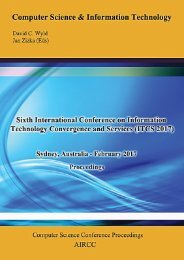CoSIT 2017
Fourth International Conference on Computer Science and Information Technology ( CoSIT 2017 ), Geneva, Switzerland - March 2017
Fourth International Conference on Computer Science and Information Technology ( CoSIT 2017 ), Geneva, Switzerland - March 2017
Create successful ePaper yourself
Turn your PDF publications into a flip-book with our unique Google optimized e-Paper software.
Computer Science & Information Technology (CS & IT) 95<br />
start by sending a request for authentication by providing a list of AHP protocol version numbers<br />
it supports in a string (listed in order of preferred version numbers). The string must contain a<br />
comma separated displayable characters, with two zeros as terminating character. The purpose of<br />
exchanging version numbers between client and server is that in case either of the parties does not<br />
support some newer version numbers, the client and server can synchronize on which AHP<br />
protocol version they can use for the successful handshake.<br />
5.3.2. AuthAck<br />
The server will check to make sure the version numbers are acceptable and respond to the client<br />
with a version number string of its own (similar string format as client version number string).<br />
The client adjusts the protocol to the server required version number. Note that, for security<br />
reasons, only the server can decide on what AHP protocol version number to use. If the server<br />
does not support or agree on the client’s desired version number, the connection is terminated.<br />
5.3.3. AuthAccount<br />
The client provides user account id information along with its CA certified digital certificate and<br />
public key. Once the server receives the necessary information, it checks the client’s certificate<br />
with certificate authorities for authenticity and extracts domain information. Now the server must<br />
check to ensure that the user account id exists and the client has been authorized to access the<br />
account. The connection will be terminated if any of these steps fails to complete successfully.<br />
Note that although SSL provides an optional client verification, we will perform the client<br />
verification as a mandatory step here. This extra step ensures that even if the user account’s key<br />
were compromised, the key would not be accepted from an unauthorized client.<br />
5.3.4. AuthChallenge<br />
The server creates a challenge string made up of an arbitrary length of random numbers, and then<br />
encrypts it with the user id’s public key and sends the challenge string to the client. The random<br />
number can prevent a forward attack at which the challenge string cannot be reused for future<br />
authentication.<br />
5.3.5. AuthResponse<br />
The client must first decrypt the user account’s private key utilizing a pass-phrase, then decrypt<br />
the challenge string and send it to the server.<br />
5.3.6. AuthComplete<br />
The server checks the decrypted string, and if there is a match, it returns AHP_SUCCESS.<br />
Otherwise, it returns an AHP_FAILED code. If authentication was successful, the HTTP<br />
request/response commands could be sent, otherwise the connection will be closed and no other<br />
data would be accepted.<br />
6. TRUST MODEL<br />
To identify a server or a client machine that we want to communicate with, a trusted source is<br />
needed to verify the identity of either of the party. We will discuss that next.





